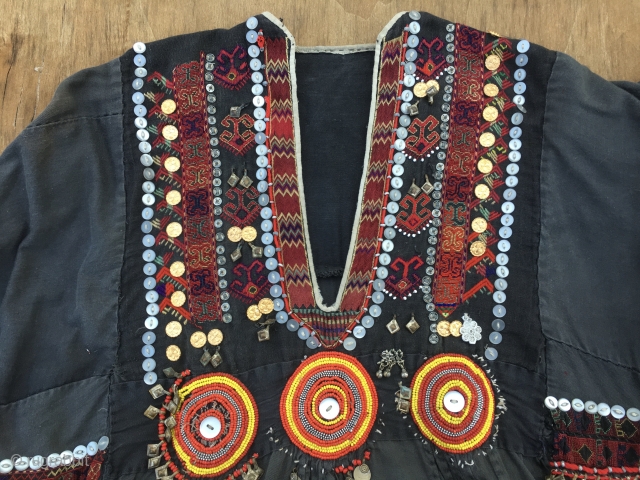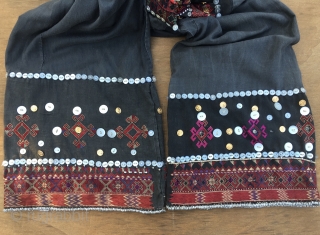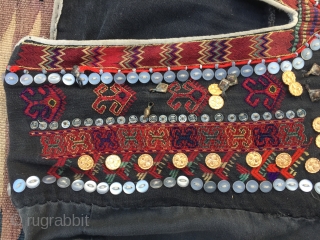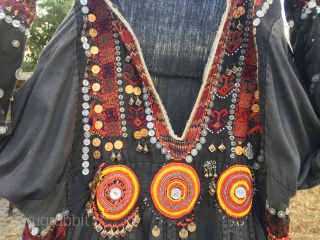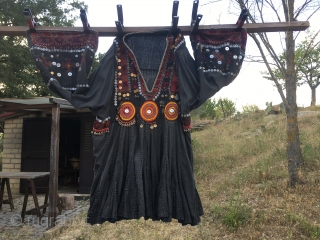Back
Nuristan. Jumlo or woman wedding dress from Kohistan/Nuristan, Northern Pakistan and Afghanistan. Heavily silk embroidered on black cotton, with lots of white and copper plastic buttons, metal roundels, lead beads, etc. Early 20th century roughly. There is a similar piece at the textile Museum in Washington. Right, this a Jumlo or woman wedding dress from Kohistan, northern Pakistan and Afghanistan, Heavily silk embroidered, with lots of white and copper plastic buttons, metal roundels, lead beads, etc. --- Here a description of a similar piece at the Textile Museum in Washington. --- This dress is made of handwoven black cotton fabric that has been embroidered with silk threads and decorated with beads, buttons and coins. At the time it was made, the dress would have been worn with a pair of pants with embroidered cuffs and a headdress in the form of a hood. The dress, pants and headdress would have been worn by the woman who made it. Very little is known about these dresses as they are rarely sold (only if the family needs money) and there are no known photographs of women wearing them. Hundreds of godets, or insets of cloth, give fullness to the skirt. Some of these dresses may have as many as 600 godets in their skirts. The simply-cut bodice and sleeves are adorned with embroidery in a cross stitch and a darning stitch. Buttons, beads and coins were sewn on for additional adornment as well as to make a tinkling sound as the wearer moved, which served to scare away evil spirits. Among the coins on this dress are two Indian coins dating from 1931 and 1939; the rest of the coins are from Pakistan, dating from 1948 to 1951.
p.s. Difficult to find a complete dress since selling the different embroidered parts separetely gives a better return.
price:
700€ + ship
- Home
- Antique Rugs by Region
- Category
- Profiles
- Post Items Free
- Albums
- Benaki Museum of Islamic Art
- Budapest: Ottoman Carpets
- Gulbenkian Museum
- Islamic Carpets. Brooklyn
- Islamic Textiles. Brooklyn
- Konya Museum: Rugs
- MKG, Hamburg
- MMA: Caucasian Carpets
- MMA: Mamluk Carpets
- MMA: Mughal Indian Carpets
- MMA: Ottoman Carpets
- MMA: Safavid Persian Carpets
- MMA: Turkmen Rugs
- McCoy Jones Kilims
- Ottoman textiles. Met
- Philadelphia Museum
- Rugs and Carpets: Berlin
- Seljuqs at the Met
- TIEM, Istanbul: Carpets
- V&A: Classical Carpets
- Vakiflar Carpets: Istanbul
- Baluch Rugs: Indianapolis
- Gallery Exhibitions
- Jaf an Exhibition
- Alberto Levi Gallery
- Andean Textile
- Christie's London: 2016
- Francesca Galloway
- HALI at 40
- ICOC Washington, DC 2018
- Jajims of the Shahsavan
- London Islamic Week April, 2018
- Mongolian Felts
- Navajo Rugs: JB Moore
- Persian Piled Weavings
- SF Tribal & Textile Art Show 2020
- SF Tribal 2019
- Sotheby's: C. Alexander
- Turkish Prayer Rugs
- Turkmen Main Carpets ICOC 2007









